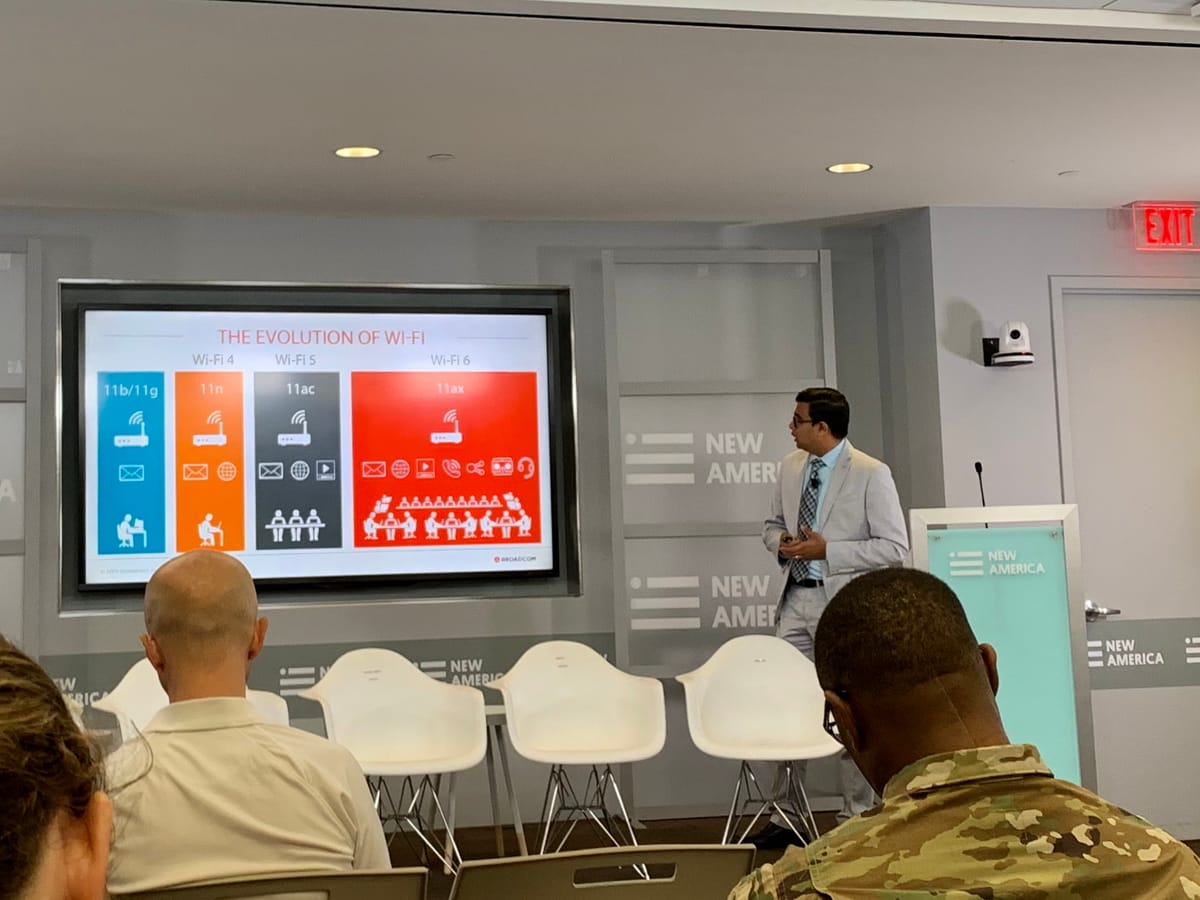Forget the Hype About 5G, Wi-Fi 6 Is Already Here, Say Panelists at New America Event
WASINGTON, June 4, 2019 – Next generation Wi-Fi – sometimes called Wi-Fi 6 – will boast many of the capacities of the hype-driven 5G wireless standard, except that the capabilities of Wi-Fi 6 are already ready to deploy, said speakers at an event on Monday. The event, entitled “Next Generation Wi-Fi
Em McPhie

WASINGTON, June 4, 2019 – Next generation Wi-Fi – sometimes called Wi-Fi 6 – will boast many of the capacities of the hype-driven 5G wireless standard, except that the capabilities of Wi-Fi 6 are already ready to deploy, said speakers at an event on Monday.
The event, entitled “Next Generation Wi-Fi: Accelerating 5G For All Americans,” was hosted by the New America’s Open Technology Institute.
Although some proponents of 5G question whether Wi-Fi will become obsolete with the rise of 5G networks, Broadcom Vice President Vijay Nagarajan said the answer to this was a “resounding no.” According to Nagarajan, the next generation of Wi-Fi will not just co-exist with 5G but actually be essential for its success.
Currently, approximately 80 percent of mobile traffic takes place over Wi-Fi. 5G will not necessarily change this figure; wireless data channels operating on higher frequencies will cover a smaller area, meaning that coverage will not be seamless without an extremely high cost.
Nagarajan’s answer to this is Wi-Fi 6 in every building, providing a cost-effective cover for cellular 5G deployments.
“5G is a wonderful technology, but [it’s] predominantly outdoor tech and Wi-Fi is predominately indoor,” explained Comcast Vice President David Don. Cellular devices all connect to subscription-based mobile carriers, of which there are many, but Wi-Fi connects to a neutral host, so anyone with the password can use the network.
Without Wi-Fi, every interior space would require a 5G connection for every single carrier, which is unlikely to happen anytime soon.
5G is expected to provide high data rates, IoT support, low latency, fixed wireless access, high mobility, and spectrum efficiency. Wi-Fi 6 will provide these same benefits: High speed, low latency, more coverage, higher capacity, and power efficiency. According to Nagarajan, cellular 5G and Wi-Fi are “complementary to each other in offering these services seamlessly.”
Many of the speakers focused on the potential to open up the 6 Gigahertz (GHz) band for unlicensed spectrum, which would add seven 160 Megahertz (MHz) channels. The current unlicensed spectrum is inadequate because there are already nine billion devices to Wi-Fi, and this number is expected to grow exponentially.
“In order to compete and provide low cost service to the people who need it most, we need unlicensed access,” said Wireless Internet Service Providers Association Vice President Christina Mason.
Opening up 6 GHz will double the bandwidth and throughput, give higher speeds over wider areas, and have the potential to be deployed in both dense areas and single-family homes. Nagarajan called it a “Wi-Fi superhighway” that would be critical to carrying traffic from 5G cellular networks.
FCC Commissioners Michael O’Rielly and Jessica Rosenworcel both spoke on the panel, providing a bipartisan show of support for opening up additional spectrum. While Rosenworcel was very optimistic about the future of Wi-Fi 6, O’Rielly was more cautious, pointing out that the schedule will be decided by FCC Chairman Ajit Pai.
The main issue with opening up 6 GHz to unlicensed spectrum is that the band is currently populated with incumbents who worry about the interference risk. Rosenworcel pointed out that the 3.5 GHz band currently accommodates military data, licensed commercial use, and unlicensed use for Wi-Fi. This model could be exported to other bands.
She also emphasized the fact that Congress specifically directed the FCC to find 100 megahertz for use within the next few years, meaning that they are actively looking for solutions.
Susan Bearden, the Chief Innovation Officer for the Consortium for School Networking, spoke about the potential importance of Wi-Fi 6 in education, emphasizing the importance of “going the last mile.”
Schools are dependent on Wi-Fi, both for educational purposes such as streaming and downloading instructional materials and for security purposes like video cameras and other high impact network devices. Students should not have to choose between the quality of their education and their safety, Bearden said.
Wi-Fi 6 will also have a significant impact on libraries. In areas where many individuals lack internet access from their homes, libraries are key for online learning and job training.
These are more likely to be supported by Wi-Fi than by 5G, given the high cost of necessary network infrastructure combined with the low density of people in certain rural communities, creating a low return on investment for carriers.
Mason said that these carriers were “overselling their commitment to deploy,” particularly for areas that still don’t even have 4G coverage. Even if carriers do offer 5G connectivity, it might still be cost-prohibitive for many. Wi-Fi 6, she said, could fill that gap.
(Photo of Broadcom Vice President Vijay Nagarajan by Emily McPhie.)









Member discussion